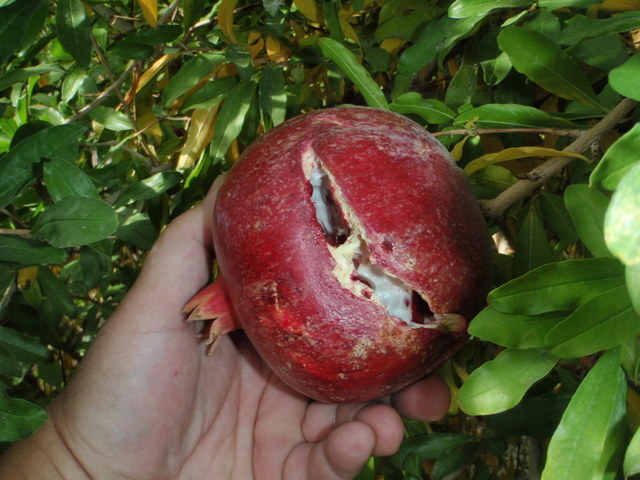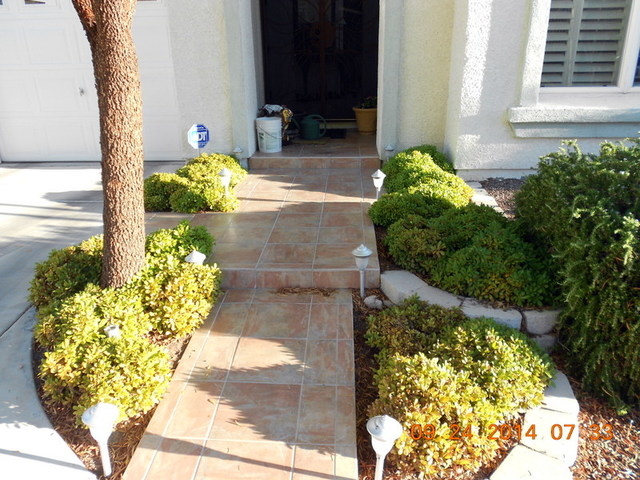Ripe pomegranate seeds aren’t always red
Q: This is my first year growing pomegranates. I harvested three. The first two I picked too early because the skin broke and I didn’t want something to go after them. I expected them to be red inside. They weren’t. They were an off-white color but they do taste good and sweet. Did I pick them too green?
A: The best time to pick pomegranates is when they are sweet. That is when they are ready for us to eat or to store for later use. We use visual clues or a calendar to tell us when they are ripe. One of these visual clues is fruit splitting. However, they can split early if they get irregular irrigations or after a heavy rain.
There are varieties of pomegranates which ripen in September and others we typically see in stores that are beautifully red inside and out, like Wonderful, which don’t ripen until about Halloween.
Some varieties don’t get red inside ever, even when they are ready to harvest. They are the color you are describing but they are still sweet. Some have soft seeds that you can eat while others have hard seeds.
You were right in picking at any time when the fruit splits. Even if it’s too early they will get destroyed by vermin or disease once they open to the environment. By picking it you prevented vermin from getting the arils or seeds. Great job! Mark your calendar with this date for next year’s harvest.
Q: You recently identified correctly my peach trees had borers in them. I found the oval larval holes under the loose bark as you described. I am removing it. Can I plant a new peach tree in the same hole? If so, are there any preventive measures I should take?
A: There is no problem planting in the same hole. This insect burrows into the tree, not the soil. This borer can fly and comes in from other infested trees including many landscape trees and shrubs in the area.
Sunburn or sunscald is the main culprit so providing shade on the trunk and lower limbs and giving it protection by applying a whitewash to the trunk and limbs help reduce sunburn and, consequently, borer attacks.
However, make sure you whitewash this new tree with either tree whitewash made from lime or diluted white latex paint, not an oil-based paint. You can use any color as long as it is a very light shade. Mix the latex paint with about the same amount of water and apply it to the trunk and main scaffold limbs.
Prune the tree so the canopy is full and shades as much of the trunk and scaffold limbs as possible. Make sure the tree receives adequate water. Apply 3 to 4 inches of a wood chips to the soil surface around the tree. The tree will perform better and have less stress if this mulch is applied.
Keep these surface mulches a safe distance from the immature trunks of plants so it does not cause trunk or collar rot. Wood mulches have good performances in our desert.
Q: I want to plant a mesquite tree but I’m not sure if I should buy a Chilean or a velvet mesquite. Do you have an opinion on these two trees?
A: Both trees do well in the Mojave Desert. Both have a similar shape and size and similar tolerance to winter cold but there are a few differences.
Chilean mesquite may also be called thornless Mesquite. A major advantage of Chilean mesquite is supposed to be its lack of thorns. However, it may develop thorns later in life.
Chilean mesquite grows faster than velvet mesquite. But this can actually be a disadvantage. Sometimes Chilean mesquite grows so rapidly its canopy can become top-heavy and may uproot in strong winds, particularly if it receives shallow irrigations.
Chilean also tends to push a lot of its energy into top growth in irrigated landscapes rather than a good balance between root and top growth. Velvet mesquite grows rapidly but not as rapidly as Chilean mesquite. It has a more balanced root and top growth.
Sometimes Chilean mesquite develops a lot of surface roots in urban landscapes that people don’t like. Velvet mesquite, on the other hand, develops a deep root system if encouraged with soil preparation at planting time and deep but infrequent watering after it is established.
I tend to favor velvet mesquite over Chilean mesquite even though it has thorns. Training its architecture, or limb structure, early in its youth goes a long way toward having a beautiful tree later on.
Water these trees deeply. Make their roots “chase” the water so it establishes a root system capable of holding the tree upright during strong winds.
Q: In the past 10 days we have experienced a major worm exodus from our yard onto the sidewalk. I recently applied a lawn fertilizer with no pesticides in it. One of these die-offs was after a heavy watering and one was after no water for two days. Is this normal this time of year?
A: It is hard to pinpoint the reason why worms did a death march out of your lawn but the usual reasons are because they can’t get enough air or some irritant is applied to the lawn.
A lack of air usually occurs because the soil is kept too wet, like right after a heavy rain, or is compacted from traffic or heavy equipment. This can be corrected by aerating the lawn once a year.
It is possible that a heavy application of fertilizer might irritate them enough so they would leave. Most fertilizers are salts. If the soil becomes salinized this could be enough of an irritant for earthworms to try an evacuation.
Quick-release fertilizers (these are the most inexpensive types) easily dissolve in water so fertilizer salts are released into the earthworm environment quickly.
Next time apply a fertilizer that has half of its nitrogen in a “slow-release” form. This releases the nitrogen more slowly, as well as the salt content, and is easier on your worms.
It is also a better fertilizer for your lawn. Slow-release fertilizers encourage moderate growth and are applied less often. Quick-release fertilizers tend to “jolt” the grass into rapid growth and then disappear quickly.
Q: I have three dwarf mock orange plants near each other growing in rock mulch. Two are a beautiful dark green. One has brown leaves on half the plant. My landscaper says the cause is sunburn. If so, do I pick off the brown leaves, let them stay on until they fall off, prune the whole plant or what?
A: Yes, rock mulch is a frequent culprit in poor growth of mock orange. Its poor performance is because of sunburn and sun damage, but this type of damage is accentuated by the rock mulch.
Organic mulches such as wood chips and the addition of compost to the top of the soil improves the health of these plants. Improved health helps these plants handle tough locations. When plant health declines they can’t handle these types of locations and thus they burn and scorch.
The reason for it being on one plant in three is probably because the others’ time is coming. It is just beginning.
Yes, you can cut them off or remove them but wait until spring unless it is really ugly now. If you remove leaves now you’re going to see a bunch of bare branches. Do you want to see bare branches or ugly leaves? Your choice.
Bob Morris is a horticulture expert living in Las Vegas and professor emeritus for the University of Nevada. Visit his blog at xtremehorticulture.blogspot.com. Send questions to Extremehort@aol.com.






























